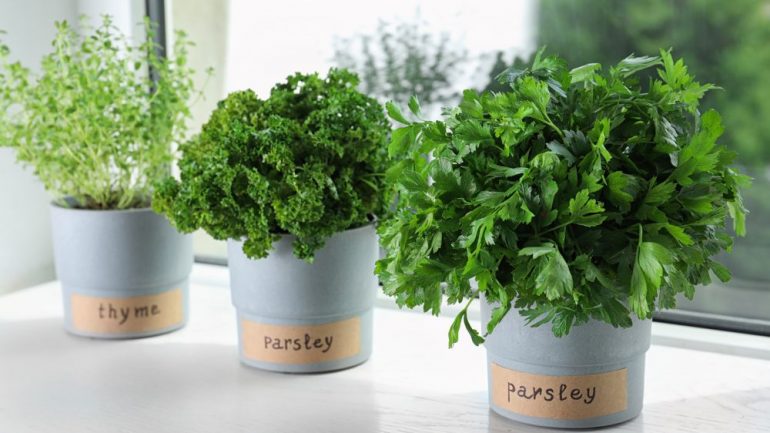Indoor kitchen gardens are fun and easy — the perfect project for novice gardeners and cooks of all ages and talents. If you’re just getting started, here’s a quick primer.
Benefits of an indoor herb garden.
For a gardener without outdoor space, or someone who wants a low-maintenance option, consider an indoor herb garden. Not reliant on outside weather conditions, they offer convenience and a way to save money on groceries. In addition, herb gardens provide a place to use your own compost instead of chemical fertilizers.
Choosing plants for your kitchen garden.
Your choices should be guided by what you use most in recipes. Also, avoid plants with deep root structure or super tall stems. Annuals and perennials both grow readily indoors under the right conditions.
Types of pots for your herb garden.
The ideal herb pot is six inches or wider in diameter with adequate drainage holes. For an inexpensive, passive hydroponic system, use mason jars. Terra cotta or clay pots will need more frequent watering because of evaporation. Galvanized metal – even soup cans – can house growing herbs; just drill small drainage holes near the bottom. Regardless, cover the inside base of the pot with small pieces of gravel, then top with potting soil.
Where to place your herb garden.
Southern-facing windows give the ideal six hours to eight hours of sunlight each day. Optimum plant growing temperatures range from 55 degrees to 75 degrees. However, be cautious of uninsulated or drafty windows, especially in winter, as your plants may get too cold. Basil especially prefers warmth to grow well. If your windows – or the season – do not permit enough exposure, place your garden under a grow light. Watch for brown spots, which indicate burning from too much time or too close proximity to the light.
Harvesting your kitchen garden.
Cut your herbs in either the morning or evening, to avoid making those places too vulnerable to harsh sunlight. Remove the leaves gently by hand or with scissors. Cut small bunches of chives close to the soil to promote new growth. Grow dill and cilantro in stages – one pot with seeds, one with moderate growth, and one ready to harvest – to prolong the growing season. Once harvested, cilantro does not grow back. Pro tip: Remove flowers from all plants to encourage new leaf production.
Using your fresh herbs.
Herbs can go directly from the plant into your cooking pot. Or, you can dry or freeze cuttings. From teas to medicinal salves and ointments, your organically grown herbs have many applications. Some, like rosemary and thyme, also have pest and insect-repelling qualities, safer than commercial pesticides for your family.
Last thoughts.
Purchase plants that have been grown indoors, as changing growing conditions abruptly can cause trauma to the plant. Place herbs in separate containers, which will promote optimal growth and prevent one from overpowering another. For optimum drainage, use high-quality organic potting soil with vermiculite or perlite. Indoor potted herbs need fertilizer or compost to replace nutrients.
Related – Creating an Outdoor Vegetable and Herb Garden


